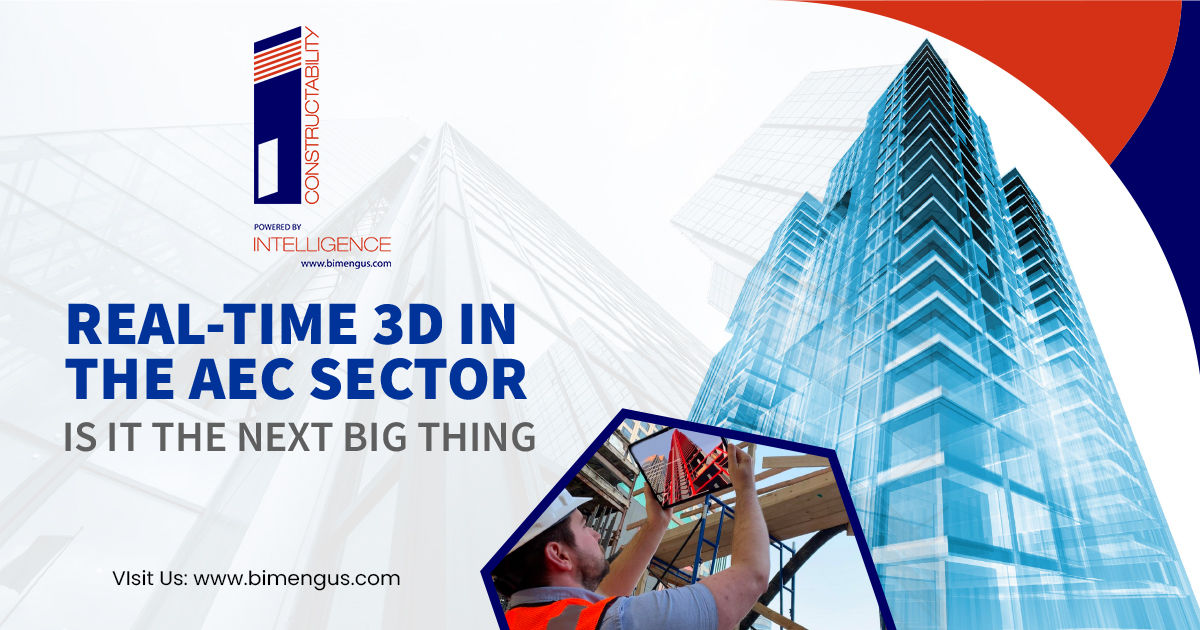3D in construction is exciting because it provides a view into an unknown world. With virtual reality, viewers can explore a new landscape and build wonders inside. 3D in the AEC sector is equally transformative, but for many different reasons. Instead of scouting for possible building sites and analyzing the layout to see if it’ll work, designers will be able to quickly evaluate architectural options within seconds. Great ideas that would have taken time to come up with will now be able to be instantly implemented as they are conceptualized. Real-time 3D visualization solutions are also expected to bring cost savings at the end of the day. The savings will come from reduced measuring costs, less time spent redrawing plans, and more efficient scheduling processes. Below we explore how real-time 3D is being used in other sectors, as well as its potential use in the AEC sector.
What is Real-Time 3D?
Real-time 3D is a type of technology that allows a user to view and interact with a 3D scene through a computer or mobile device. The virtual environment represents a real-world scene that can be navigated and interacted with in real-time. Real-time 3D also allows for the creation of spatially accurate animations that are largely driven by computer vision technology. Real-time means that the computer is processing images and creating a digital scene at the same time that 3D visualization is being projected. The result is a smoother experience with less lag time and more natural interaction between digital and physical objects. Real-time 3D is the next step in a technological progression that dates back to the late 19th century when architects used high-speed photography to create blueprints.
Uses of Real-time 3D in Construction
Real-time 3D is used as an innovation tool to improve visual communication between engineers and designers. In the construction industry, engineers use 2D drawings to communicate their ideas to architects and level designers. However, it is difficult to communicate everything in drawings and on paper, especially when planning large-scale projects. Using real-time 3D, project managers and engineers can create 3D models and show their designs to the rest of the team, which allows everyone to understand their ideas better. Real-time 3D can also be used to visualize construction sites and show stakeholders virtual tours of the planned building. Real-time 3D can also be used in construction to show stakeholders and clients a walkthrough of the building project before it even begins. In these scenarios, clients can see the finished product of the project even though it hasn’t been built yet. This not only helps communicate the engineering of the project but also helps communicate a project schedule that is often difficult to communicate in 2D.
Benefits of Real-time 3D in the AEC Sector
Real-time 3D allows architects to quickly visualize their design options and choose the best solution. With this new technology, it will be easier to see the potential in new ideas, and the visual communication between engineers and designers will increase. The same can be said for project managers and construction managers, who can now quickly see the design of the project and communicate with their team members. Real-time 3D will also improve construction scheduling processes. Currently, engineers or managers are often the ones drawing up plans based on physical measurements. With real-time 3D, they can use computer vision technology to digitally measure the same site, reducing the need for physical measurements. As a result, the cost of measuring a site will decrease, allowing for shorter construction schedules.
Real-time 3D and the future of construction visualization
The construction industry is highly visual. Studies have shown that 90% of communication in the construction sector relies on visuals, including sketches, 2D drawings, and 3D models. Real-time 3D is expected to become a more common visual tool in the construction sector. The biggest challenge for this technology is the lack of advanced computer vision algorithms that can process inputs from a variety of sensors. Advanced computer vision algorithms are needed for real-time 3D, and a lot of investment is needed for this to become mainstream. According to a report by Allied Market Research, the global real-time 3D market is expected to grow at a CAGR of 63.9% to reach a market value of $1,300.8 Mn by 2023. Real-time 3D can be used to create virtual walk-throughs, architectural models, and 3D models of construction sites.
Real-time 3D and the future of construction visualization
Real-time 3D is expected to become a more common visual tool in the construction sector. The biggest challenge for this technology is the lack of advanced computer vision algorithms that can process inputs from a variety of sensors. Advanced computer vision algorithms are needed for real-time 3D, and a lot of investment is needed for this to become mainstream. According to a report by Allied Market Research, the global real-time 3D market is expected to grow at a CAGR of 63.9% to reach a market value of $1,300.8 Mn by 2023. Real-time 3D can be used to create virtual walk-throughs, architectural models, and 3D models of construction sites.
Visit Us: www.bimengus.com
